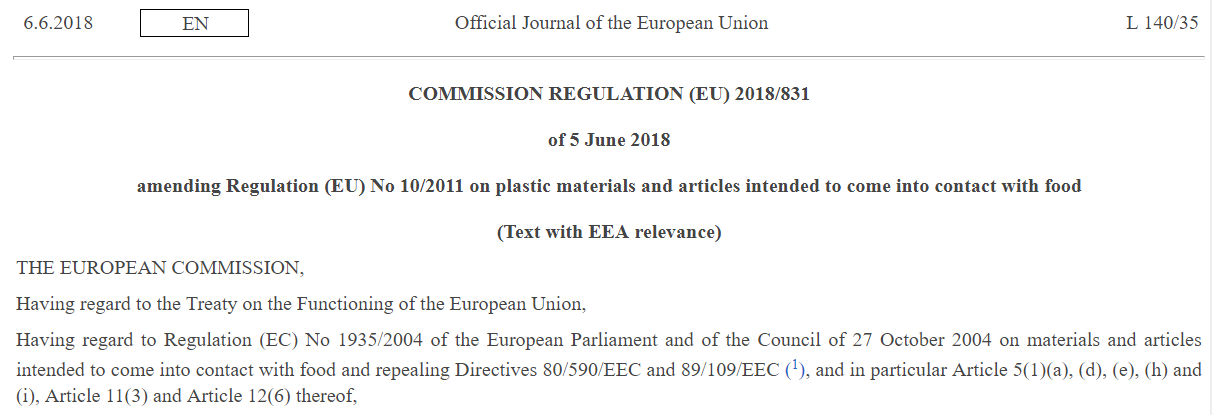6 June 2018, the Official Journal of EU issues the (EU) 2018/831, amending Regulation (EU) No 10/2011 on plastic materials and articles intended to come into contact with food. The new regulation adds 1,2,3,4-tetrahydronaphtalene-2,6-dicarboxylic acid, dimethyl ester and [3-(2,3-epoxypropoxy)propyl]trimethoxy silane, and also amends the use of Perchloric acid, salts and phosphorous acid, mixed 2,4-bis(1,1- dimethylpropyl)phenyl and 4-(1,1- dimethylpropyl)phenyl triesters. Directive (EU) 2018/831 shall come into force on 26 June 2018.

Annex I to Regulation (EU) No 10/2011 is amended as follows:
1. The entries of No 822 and No 974 in in point 1, Table 1 are replaced by the following:
Substance No. CAS No. Name of Substance Specific Migration Limit Restrictions and Norms 822 Perchloric acid, salts 0.002 974 939402-02-5 phosphorous acid,
mixed 2,4-bis(1,1- dimethylpropyl)phenyl and 4-(1,1- dimethylpropyl)phenyl
triesters 10 SML expressed as the sum of the phosphite
and phosphate forms of the substance, 4-tert-amylphenol and
2,4-di-tert-amylphenol. The migration of 2,4-di-tert- amylphenol shall not
exceed 1 mg/kg food.
2. the following entries are added in numerical order of the FCM substance numbers:
Substance No. CAS No. Name of Substance Specific Migration Limit Restrictions and Norms 1066 23985-75-3 1,2,3,4-tetrahydronaphtalene-2,6-dicarboxylic
acid, dimethyl ester 0.05 Only to be used as a co-monomer in the
manufacture of a polyester non-food contact layer in a plastic multilayer
material, which is to be used only in contact with foods for which food
simulants A, B, C and/or D1 are assigned in Table 2 of Annex III. The
specific migration limit in column 8 refers to the sum of the substance and
of its dimers (cyclic and open chain). 1068 2530-83-8 [3-(2,3-epoxypropoxy)propyl]trimethoxy
silane Only to be used as a component of a
sizing agent to treat glass fibres to be embedded in glass-fibre-reinforced
low diffusivity plastics (polyethylene terephthalate (PET), polycarbonate
(PC), polybutylene terephthalate (PBT), thermoset polyesters and epoxy
bisphenol vinylester) in contact with all foodstuffs. In treated glass fibres, residues of the
substance must not be detectable at 0,01 mg/kg for the substance and 0,06
mg/kg for each of the reaction products (hydrolysed monomers and
epoxy-containing cyclic dimer, trimer and tetramer).
This directive shall be binding in its entirety and directly applicable in all Member States. Prior to the effective date, (EU) 10/2011 compliant plastic materials and products could still be put on the market until February 9th 2019 until they were sold out.
|Further Information:
Notice of the OJ adding two substances as food contact materials
|Our Service:
